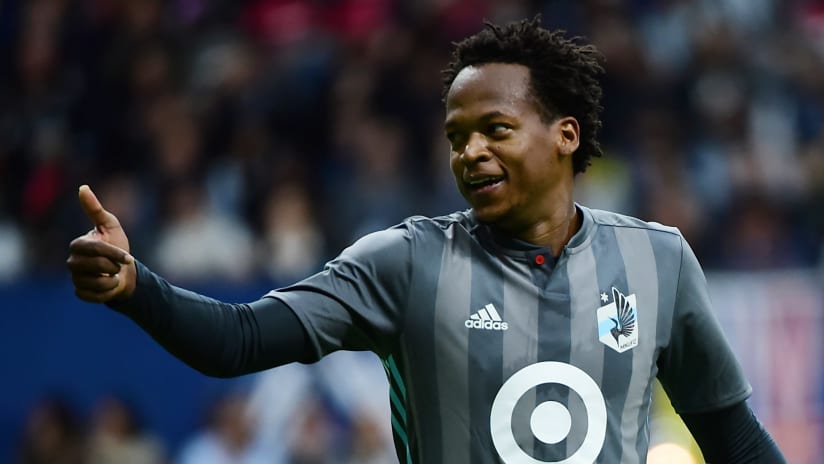POSSESSION IS NINE-TENTHS OF THE LAW
Since arriving in Minnesota, Head Coach Adrian Heath has often made it clear that his preferred method of attack is breaking down the opposition through possession. The personnel he’s had to work with, however, have not always been up to the task. In their first two years in the league, the Loons found a good deal of their offensive success through counterattacking. Although Quintero’s arrival gave the team an individual player who could draw double teams and open up space with the ball at his feet, it was not really until the first game of 2019 that we’ve gotten to see a Heath team with confidence in possession.
Much work remains to turn their possession into a finely tuned machine, but the Loons displayed a very conservative offense overall — likely in part because of wanting to play from possession and in part from wanting to maintain defensive shape. Taken together, those two elements provide a stable platform from which to build the offense out over the early going of the season. It makes sense: establish the principles of getting back solidly on defense and moving the ball confidently around the midfield before adding subtlety to the attack. In the parlance of competitive video gaming, this is called "playing your life." It means that in a game where you have multiple lives, your main concern is preserving the life you have. It's the idea that scoring points is less important than keeping the other team from scoring points — a viewpoint that can be particularly useful when you're still dialing in your approach and identity in a competition.
Against San Jose, the team will have to cope with the Quakes’ aggressive man-marking off the ball. This may force them to get more creative quickly with how they open up space if they find themselves stymied in their own half early.
REDUCING THE MARGINS
Planning is overrated. As Mike Tyson once memorably said, “Everybody has a plan until they get punched in the mouth.” No matter how well a team trains and drills, luck and risk are always going to play their part when it comes to the actual game. The trick is blending preparation with the recognition of opportunity, and that means every team needs a mix of players: some controllers, some catalysts and some gamblers.
Now obviously, players are not usually 100% one of these things. Darwin Quintero — for example — is manifestly a catalyst but also evinces some gambler tendencies. By nature of being a defender, Calvo spends some amount of time as a controller at the back, but at heart he’s really a gambler. Adding guys like Ike Opara, Ozzie Alonso and Jan Gregus to the likes of Michael Boxall and Rasmus Schuller has provided a critical mass of stability and control that allows the gamblers and catalysts a more productive level of freedom.
Most successful soccer involves an element of risk and luck: the defense thinks they have a solid plan and to break it down, you have to open yourself to some risk. More controllers on the team is simply reducing the margin of error leading up to that risk. Instead of a series of tricky passes, you might only need one after a string of successful possession. Instead of being forced into a last-ditch defensive effort, the team thwarted attacks much farther up the field. Against Vancouver, MNUFC looked both more capable of delivering a punch and taking one because of having reduced their margin of error with experienced, high IQ players.
WHEREFORE ART THOU ROMARIO?
With Angelo Rodriguez still working his way back to full fitness after suffering a knock in preseason, the responsibility up top to start against the Whitecaps fell to Romario Ibarra. Although Romario’s position is generally as a left-sided winger, he showed enough flashes toward the end of last season to make Heath comfortable with the change. In 2018, he shifted forward a number of times following substitutions and even lined up as the starting forward against the Portland Timbers on September 22, scoring a brace.
Against the Whitecaps, however, his role lacked a bit of clarity. Instead of riding the backline between centerback Erik Godoy and Doneil Henry and waiting for the right moment to cut through and get on goal, he often dropped back behind Darwin Quintero and played more in the manner of Rodriguez. As a big, strong forward, this role fits Rodriguez well. It allows him to receive the ball from the deeper midfielders and hold off his defender while the other attackers move past him to set up in space and receive passes. But one of Romario’s best assets is his speed and playing a hold-up role negates some of that effectiveness.
Overall, he wasn’t completely squandered, obviously. He scored a goal in the 70th minute, notably after Quintero forced a turnover in Vancouver’s half and Romario sprinted out ahead to pick up the loose ball. But if he starts again, it will be interesting to see if his role on the field becomes a little clearer and more focused against San Jose after another week of training and feedback from the coaching staff.





